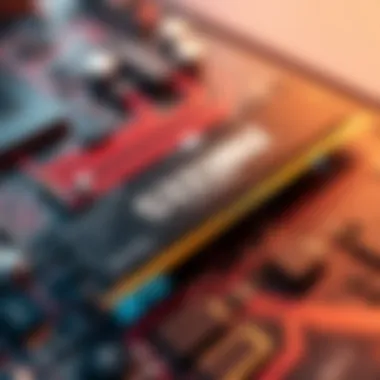Exploring 5333 MHz RAM: Performance and Selection Guide


Intro
In the fast-paced realm of computing, where every millisecond counts, the type of memory you choose can significantly affect your system's performance. Among the myriad of available options, 5333 MHz RAM has carved out a niche, promising to deliver exceptional speed and efficiency. It’s essential to understand what this high-frequency memory brings to the table, especially for tech enthusiasts and professionals who aim to enhance their devices.
This section sets the stage for a deeper examination into various facets of 5333 MHz RAM — from its core features to performance metrics, compatibility issues, and practical buying advice. As we navigate through this comprehensive analysis, we'll unravel the potential advantages and consider alternatives, giving you a clear picture of whether this memory type is right for your specific needs.
Understanding RAM Basics
In the realm of computing, Random Access Memory (RAM) acts as the main facilitator of operational efficiency, serving as the temporary storage space where data is processed immediately. Grasping the fundamentals of RAM is crucial, particularly when delving into higher frequency options such as 5333 MHz RAM. For tech enthusiasts and professionals alike, understanding these aspects becomes essential when building or upgrading systems.
An appropriate comprehension of RAM types, features, and performance characteristics can mean the difference between a sluggish system and one that runs smoothly and efficiently. Different forms of RAM serve unique roles within the system architecture and deliver varying levels of performance. Learning about these differentiating factors prepares users to make informed decisions when choosing RAM that best suits their needs.
What is RAM?
RAM, or Random Access Memory, is a critical component that temporarily holds data and machine code currently in use. It allows for quick read and write access, essential for smooth multitasking and application performance. Imagine RAM as a messy workbench: a larger bench allows for more tools and materials to be laid out, so you can complete tasks more swiftly. When the workbench is overcrowded or small, work slows down.
The speed at which RAM operates, often denoted in megahertz, directly impacts how effectively a computer handles multiple tasks at once. As seen recently, RAM frequencies have hit new highs, such as the emerging trend of 5333 MHz RAM, which ignites intrigue about its potential benefits and implications.
Types of RAM
SDRAM
Synchronous Dynamic Random Access Memory (SDRAM) operates synchronously with the system clock, enabling it to keep pace with processing requirements effectively. One of SDRAM's standout features is its faster data transfer rates compared to traditional DRAM. This efficiency makes it a solid choice for general computing tasks, though it’s now considered somewhat outdated for modern performance needs.
In essence, SDRAM serves as the groundwork for subsequent RAM types. While it may not provide the turbocharged speeds found in later variants, its reliability and stability laid the foundation for more sophisticated technologies.
DDR
Double Data Rate Synchronous Dynamic Random Access Memory (DDR) marked a significant leap in memory technology. By allowing data transfers on both the rising and falling edges of the clock signal, DDR effectively doubles throughput without increasing the clock rate. This characteristic makes DDR an appealing choice for those seeking a balance between performance and cost.
Despite being outclassed by newer standards, DDR's simplicity and compatibility with older systems still make it a favored option among budget-conscious users.
DDR2
DDR2 brought about enhanced data rates and lower power consumption compared to its predecessor, DDR. Its ability to support faster speeds while requiring less voltage was a game-changer in energy efficiency. This made it suitable not only for desktop systems but also for laptops, extending battery life and improving performance on portable devices.
However, as applications evolved and system demands grew, DDR2 began to seem sluggish, paving the way for subsequent technologies.
DDR3
With DDR3, the memory technology took another qualitative leap. The increased bandwidth and lower latency components compared to DDR2 amplified its appeal, especially in gaming and high-performance computing scenarios. DDR3 facilitates efficient multitasking, allowing multiple apps to run smoothly side by side.
Yet, users also found hurdles in terms of compatibility with older equipment, necessitating thoughtful consideration when upgrading.
DDR4
DDR4 enhanced bandwidth even further, introducing improved reliability features such as error correction. This generation brought significant boosts in speed without a substantial increase in energy consumption. For users delving into more intensive applications—video editing, gaming, or data analysis—DDR4 provides a more future-proof solution.
Though alluring for mid-range builds, an understanding of optimal compatibility becomes vital since load requirements increase.
DDR5
Finally, we come to the next frontier: DDR5. This latest standard promises unprecedented speed increases and better power efficiency. Notably, it can manage larger amounts of memory while reducing latencies—a significant advantage for data-heavy tasks.


Though it may not be universally compatible with older systems, those willing to invest in cutting-edge technology will find DDR5 worth their while as it drives forward system performance at unprecedented levels.
In summary, each of these RAM types contributes uniquely to the evolution of memory technology, shaping how users experience computing today. The transition to 5333 MHz RAM necessitates a solid understanding of these fundamental types in order to maximize potential performance gains.
Frequency and RAM Performance
When it comes to RAM, frequency is far more than just a number on the specs sheet. The frequency of RAM, measured in megahertz (MHz), essentially determines how quickly it can send and receive data from the processor. In the realm of modern computing, especially as we dive into 5333 MHz RAM, understanding its importance is vital for anyone looking to elevate their system's performance.
Upgrading to a higher frequency not only enhances the data throughput but can also be a game changer in resource-intensive tasks such as 3D rendering or gaming. The performance boost, in simpler terms, can be thought of as a smoother ride on the tech highway. However, with speed comes the need to consider various factors such as latency and compatibility, which can impact overall performance.
Evaluating RAM Frequency
Impact on Speed
Speed is the name of the game when talking about RAM frequency. A higher frequency typically means that the RAM can process more cycles per second. This translates into faster access to data and improved responsiveness across all applications. The crux of the matter is that 5333 MHz RAM can contribute significantly to reducing bottlenecks in data-heavy tasks. Think of it as giving your system a turbo boost when cruising down the fast lane.
One unique characteristic of the high frequency is its ability to work seamlessly with modern CPUs that support higher data rates. This is what makes faster RAM like 5333 MHz a sought-after choice among tech enthusiasts and gamers looking for that edge in competitive performance. However, it's worth noting that while the speed increase can be substantial, real-world gains can vary based on the specific applications used and the overall configuration of the system.
Latency Considerations
Latency, often measured in nanoseconds, is crucial when considering RAM performance. It refers to the time delay between the command and the action—basically, how quickly the RAM can respond once it is called upon. A common misconception is that higher frequency always trumps latency; however, the two must be balanced effectively for optimal performance.
For instance, while 5333 MHz RAM may offer higher speed, if the latency associated with it is also higher compared to its slower counterparts, the performance gain might not be as substantial as one would expect. The key characteristic here is the timing associated with the RAM, often represented in numbers like CL (CAS latency). Lower latency means faster response times, which balances the scales. In scenarios that prioritize swift responses, such as gaming or real-time data processing, understanding these intricacies can profoundly influence choice.
The Case for MHz RAM
Performance Implications
The implications of choosing 5333 MHz RAM can be substantial for a variety of users. For high-end gaming rigs and professional workstations, where every millisecond counts, the performance benefits are tangible. This RAM can facilitate quicker load times, render graphics more efficiently, and overall enhance the user experience by minimizing lag.
Computers and software are continuously evolving, and with them, so too are the demands placed on RAM. Utilizing 5333 MHz models positions users to adequately meet these challenges head-on. However, while the benefits are clear, one must also weigh in potential overkill for less demanding tasks, for which such capabilities might go unused.
Use Case Scenarios
In terms of use case scenarios, 5333 MHz RAM finds its place primarily among gamers and content creators. Gamers running the latest AAA titles at ultra settings will undoubtedly benefit from the high-frequency RAM, as it allows for faster texture loading and overall smoother gameplay.
On the other hand, professionals engaged in video editing or 3D modeling can also experience significant advantages with 5333 MHz installations, especially during rendering phases where every ounce of speed counts. However, casual users or those with simpler computing needs may find that lower frequency RAM suffices, arguing that the additional cost would not yield any proportional benefit to their use cases.
Balancing your needs against the capabilities of RAM is crucial for making informed choices.
Compatibility and Integration
When it comes to upgrading or selecting 5333 MHz RAM, the compatibility and integration aspect plays a crucial role. This section focuses on the specific elements required to ensure that high-frequency RAM can perform optimally within your system. Understanding how different components interact is essential, as it can dictate the overall performance and stability of your PC.
Motherboards and Chipsets
Supported Standards
Supported standards for RAM, particularly in the context of 5333 MHz memory, are pivotal for system compatibility. Most modern motherboards accommodate various RAM standards, such as DDR4 and DDR5, which are necessary for harnessing the benefits of higher frequency RAM. In this case, 5333 MHz RAM typically works with DDR5 slots, which are designed for speed and efficiency.
A key characteristic of supported standards is their ability to facilitate higher data transfer rates while maintaining low power consumption. Utilizing DDR5 not only delivers better performance but also enhances power management, making it a favorable option for tech-savvy users.
However, one of the unique features of these supported standards is their backward compatibility with older versions. This can be advantageous for users wanting to upgrade without completely overhauling their existing systems. But a drawback that should not be overlooked is that when pairing newer RAM with older motherboards, max performance might not be fully realized due to the limitations of older tech.


BIOS Settings
BIOS settings are another critical component when integrating 5333 MHz RAM. The BIOS acts as the bridge between hardware and the operating system, ensuring that all components communicate effectively. A prominent feature of modern BIOS is the automatic recognition of new RAM speeds and its ability to adjust settings accordingly. This drastically simplifies the user experience when upgrading.
One of the essential benefits of having correct BIOS settings is that they often allow users to tweak performance profiles, enabling enhanced memory speeds beyond standard specifications—for those who wish to dive into overclocking. Nonetheless, there’s a caveat: incorrect BIOS configurations can lead to system instability. Users need to navigate these settings cautiously. Ensuring that your motherboard's BIOS is up to date can mitigate many of these risks.
Operating Systems and Software
Utilization Under Different OS
When it comes to the utilization of 5333 MHz RAM across different operating systems, it’s vital to consider how effectively each OS can utilize high-speed memory. Operating systems such as Windows 11 and various Linux distributions have made significant strides in taking advantage of advanced RAM technologies, improving their memory management techniques.
A key characteristic of modern operating systems is their dynamic memory allocation, which allows for better utilization of available RAM resources. This makes higher frequency RAM, like 5333 MHz, particularly beneficial in environments where multitasking and high-performance applications are common.
Nevertheless, not all operating systems are created equal concerning RAM compatibility. Some legacy systems may not fully recognize or utilize the potential of high-frequency RAM. As a result, users running older versions of operating systems may not experience the same speed benefits as their more modern counterparts.
Software Optimization
Software optimization for utilizing 5333 MHz RAM can make all the difference in achieving peak performance. Applications, especially those designed for gaming or resource-intensive tasks, can be optimized to leverage higher memory speeds, enabling faster loading times and smoother operation.
One significant benefit of software optimization is that it ensures better resource allocation, leading to enhanced user experiences. High-performance gaming titles and professional software like Adobe Creative Suite can capitalize on the speed advantages of 5333 MHz RAM, allowing for real-time processing and rendering.
However, a drawback can arise when software fails to optimize for high RAM frequencies. If a program is not designed with modern RAM capabilities in mind, users may find themselves with their new 5333 MHz RAM underutilized, essentially running at lower frequencies. Therefore, proper software updates and enhancements are paramount to realize the full value of the hardware investments.
Comparative Analysis of RAM Frequencies
When it comes to understanding the dynamics of memory in computing, comparing RAM frequencies cannot be overlooked. Each frequency has its own set of advantages and limitations that cater to different user requirements. As technology marches on, the differences between memory types become more pronounced, warranting a thorough analysis. Evaluating RAM frequencies allows users to make informed decisions based on performance metrics and specific use cases.
MHz vs Other Frequencies
Performance Benchmarks
Performance benchmarks serve as a critical metric for evaluating the effectiveness of RAM frequencies. In this context, 5333 MHz RAM frequently shines in comparisons, demonstrating substantial improvements in responsiveness and data processing speed compared to its slower counterparts. It's like comparing a well-tuned sports car against a family sedan; the former accelerates faster and responds to road conditions more adeptly.
The benchmarks often highlight that gaming and content creation tasks see noticeable improvements with 5333 MHz RAM. This frequency can significantly reduce loading times in demanding applications, which is a crucial factor for professionals and avid gamers.
Nevertheless, it’s essential to acknowledge that higher frequencies can come with trade-offs. For instance, the cost involved in setting up 5333 MHz is often higher. Users should evaluate whether the speed gained justifies the investment.
Price vs Performance
Price considerations are equally central when addressing the 5333 MHz RAM in comparison to lower frequencies. The price vs performance ratio outlines how much bang you get for your buck. 5333 MHz RAM typically commands a premium price tag, but the return on investment can be substantial if your tasks demand high-speed processing.
This becomes particularly pertinent for gamers and graphical designers who push their systems to the limit. However, those whose tasks predominantly include basic computing might find that the cheaper options don’t significantly impact their experience. Here, the unique feature of 5333 MHz RAM lies in its capacity to combine high performance with reliability, although at a higher cost that might not resonate with budget-conscious consumers.
Future Trends in RAM Technology
As technology continues evolving at breakneck speed, looking at future trends in RAM technology becomes not just relevant, but necessary for anyone looking to invest wisely.
Emerging Standards
Considering emerging standards in RAM, technologies like DDR6 on the horizon promise to redefine performance metrics yet again. Staying updated with these developments is key because they can impact everything from pricing to compatibility. It's fascinating how each iteration tends to bring along significant advancements in speed, bandwidth, and power efficiency. This makes it all the more crucial to stay educated about what’s coming down the pipeline.
The unique feature of these emerging standards is the potential for increased data transfer rates, supporting the ever-growing demands of modern applications. The downside, however, is that consumers might find themselves at a crossroads when trying to balance performance needs with budget constraints.


Predictions for RAM Advancements
Predictions for RAM advancements highlight a future filled with even greater bandwidths and speeds. Experts suggest that future RAM technologies will adopt innovative methods to enhance memory efficiency and speed. These advancements promise to further bridge the gap between performance and energy consumption, an area increasingly prioritized as systems become more complex.
The unique feature lies in the advent of smarter RAM, which may self-adjust based on the tasks at hand. While this creates exciting opportunities, potential disadvantages include the inherent risks of early adoption, whereby users might encounter compatibility issues or bugs.
Selecting the Right RAM for Your Needs
Choosing the right RAM isn't just a matter of plopping a stick in your computer. It's about matching memory to what you plan to do with your machine. With RAM options as varied as the colors in a painter's palette, understanding what fits your unique requirements is crucial. The wrong choice can lead to subpar performance or wasted money, and in the tech world, that’s like throwing money down the toilet. So, let's break this down.
Assessing Your Requirements
Gaming vs Professional Use
When diving into the gaming versus professional use consideration, the biggest question is how memory affects your experience. If you're gaming, low latency and quick access times mean smoother graphics and less stuttering. High-frequency RAM, like the 5333 MHz type, can significantly enhance the frame rates in many titles, especially in open-world scenarios where every millisecond counts. That said, when it comes to professional use, things shift. Creative software like Adobe Premiere Pro or AutoCAD thrives on ample memory bandwidth. Here, fast RAM can expedite rendering times, which is an obvious boon for productivity. The trade-off is that sometimes those high frequencies don’t bring as noticeable benefits for less demanding tasks, like word processing or browsing.
Budget Considerations
Now, let’s get down to brass tacks and talk about budget considerations. RAM can be a hefty investment, particularly if you're eyeing high-frequency variants like the 5333 MHz. The key here is balancing your needs with what you’re willing to spend. Will investing in premium memory yield substantial gains in your daily workflow or gaming experience? If you're only playing casual games or doing light office tasks, splurging might be asking for trouble.
For budget-conscious consumers, researching prices across various brands can save you some cash. With frequent sales and deals popping up, you might uncover higher-quality models at competitive prices. Always keep an eye on what you need versus what is simply nice to have, as that will help avoid buyer's remorse.
Brands and Models to Consider
Getting into the nitty-gritty of brands and models is vital for making informed choices. Not all RAM is made equal, even if it’s all advertised as 5333 MHz. A solidly reputable manufacturer can make a world of difference in reliability and performance. Brands like Corsair, G.Skill, or Kingston offer extensive testing on their memory products.
Reputable Manufacturers
Going with longstanding, reputable manufacturers is often a smart move. These companies tend to have stringent quality checks and excellent customer support. If you encounter issues down the line or wish to overclock your RAM, knowing that you have a helpful support team behind you can provide peace of mind. A unique feature of these manufacturers is often a substantial warranty period, meaning they stand behind the products they sell. This can be a major selling point for users aiming to build robust systems that can hold up under intensive tasks.
Popular MHz RAM Models
Finally, let’s look at specific models that have gained popularity among tech enthusiasts and gamers. Popular 5333 MHz RAM models consistently receive praises for blending performance with reliability. Look for options like G.Skill Ripjaws V and Corsair Vengeance LPX, both known for delivering excellent performance while often being priced affordably. Their heat spreaders can keep temperatures in check during those long gaming marathons.
But remember, the best RAM will depend on your specific system layout and intended use. Be thorough in your research; make sure your motherboard can handle the increased speed and capacity. It’s crucial to note that not all motherboards unleash the full potential of faster RAM, and that’s a detail that can’t be overlooked.
Selecting the right RAM is not just a matter of speed; it’s about what aligns with your unique computing needs.
The End and Final Thoughts
Wrapping up our discussion on 5333 MHz RAM, it's crucial to reflect on the content we've traversed. High-frequency RAM like this model is carving a niche in the world of computing, acting as a significant contributor to overall system performance. As technology progresses, the demand for speedier and more efficient memory continues to rise. Understanding these dynamics, as we've explored, equips users with the knowledge necessary to make informed decisions.
The highlights from our analysis underscore not just the performance benefits provided by 5333 MHz RAM, but also its compatibility with modern systems. There's more to performance than just frequency; considerations around timings and latencies also play a pivotal role in determining a RAM module’s efficacy. In essence, this isn't just about picking the fastest RAM on the shelf. It's about strategic selection tailored to one's specific needs, whether that be for gaming, professional applications, or simple day-to-day tasks.
It's also pertinent to consider the broader implications on future system upgrades. As the tech landscape evolves, understanding the benefits and limitations of different RAM frequencies helps in future-proofing investments in hardware.
Key takeaways: Always assess compatibility with your motherboard and consider the applications that will demand more from your RAM.
Recap of Key Points
- Performance Benefits: The 5333 MHz RAM affords higher speeds which can significantly boost processing efficiency, relevant especially in memory-intensive tasks.
- Compatibility Factors: Physical configuration with motherboards is crucial. Not all systems can support this high-frequency memory, so checking compatibility beforehand is essential.
- Diverse Applications: This RAM is not a one-size-fits-all solution; tailoring your choice to the intended usage, whether for gaming or heavy computational work, is entscheidend.
- Cost-Benefit Analysis: While these modules are often more expensive, the return on investment is realized in performance gains, which is especially true for enthusiasts and professionals.
Implications for Future Purchases
When you're pondering future purchases, the choice of RAM frequency is a consideration that shouldn't be taken lightly. The tech world is dynamic; what is top-tier today may become mainstream tomorrow. Investing in 5333 MHz RAM can offer a competitive edge, particularly for those looking to enhance gaming experiences or professional workflows.
Additionally, the growing emphasis on integrated graphics and AI capabilities suggests that faster RAM may soon transition from a performance luxury to a necessity. As software becomes more sophisticated and resource-intensive, having more capable hardware, especially in terms of RAM, becomes vital.
- Remember: If you're planning a build or an upgrade, assess current and future needs carefully. Investing in faster RAM could save you from frequent upgrades down the line.
- Stay Informed: As trends shift, keep abreast of emerging RAM technologies and standards to ensure you're making the best choices possible. For those enthusiasts eager for the latest, staying updated with community insights can offer valuable foresight into what works best in practice.
For further information, consider checking resources like Wikipedia and tech communities on Reddit. These platforms can provide ongoing discussions and advice for optimizing your system's performance with cutting-edge RAM technology.







